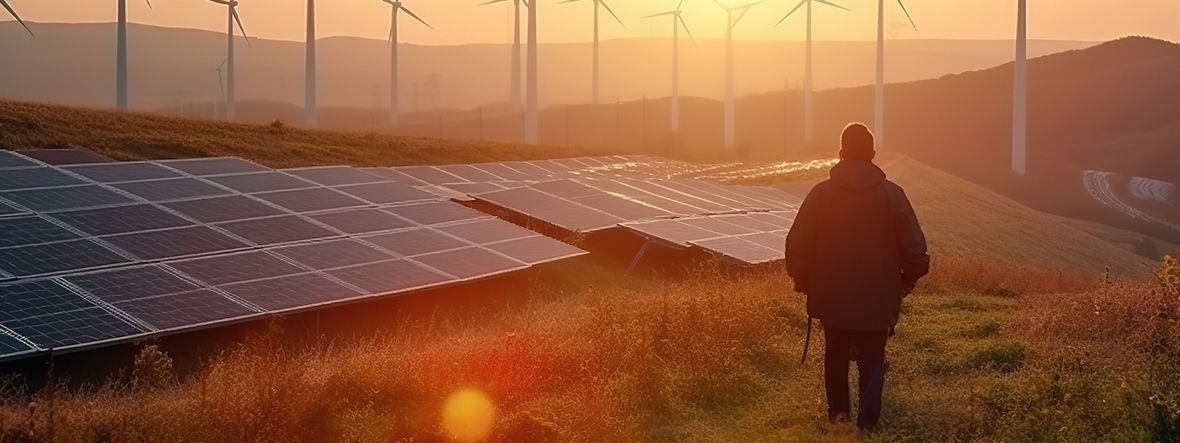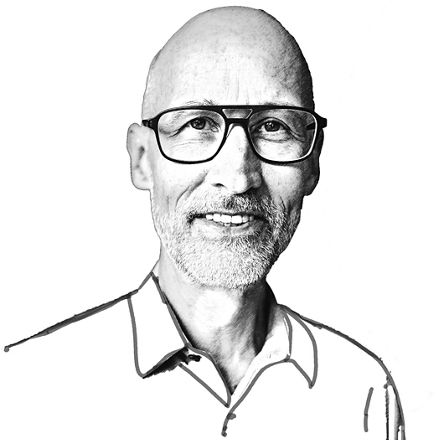The USA led by President Joe Biden has rejoined the Paris climate protection agreement, China is building wind and solar power plants at record speed year after year, and in Germany the new national government has stepped up with a very ambitious energy policy. Is humanity now moving in the right direction?
VOLKER QUASCHNING Things are moving somewhat, but unfortunately they’re still not up to speed. One way or another, we will have one hundred percent renewable energy in the year 2100. There’s only one question: Will we have destroyed the climate by then, or will we have managed to change course before that?
Do you think it’s still possible for us to change our energy generation systems in time?
It’s a technological challenge, but it’s doable.
And will we be able to pay for it?
Today renewables are the cheapest type of energy supply. Continuing to depend on coal-fired power stations and gasoline or diesel-powered cars is the far more expensive option.
Can the necessary changes be implemented at the social and political levels?
I hope the majority of the population agrees to utilize a technology that is affordable and will save us from drastic consequences.

What about the minority that opposes it?
There’s a lot of talk about “getting people on board.” But some people are sitting on their sofas at home and don’t want to get on board. We live in a democracy, so the majority should decide, and a very big majority wants to protect the climate. We can’t continue the discussion until the final holdout has been convinced. That’s also true of wind power.
Some people oppose new wind turbines precisely because they are supporters of nature conservation. For example, they claim that the rotors are endangering our population of birds of prey.
We have a split in our society. Many people have realized that we’re facing a huge problem, and they are sinking into depression because society is still acting so slowly.
At the same time, there’s a minority that is denying the problem and saying, “If we’re bent on protecting the climate, then please let’s do it without any wind turbines in my neighborhood.” It’s astonishing that in Germany the strongest resistance to wind turbines is in regions where hardly any wind turbines exist.

How can we solve this dilemma?
We have to give the local people a share of the proceeds. In Germany, wind turbines were initially built mainly by idealists and citizens’ cooperatives. Some municipalities have dozens of wind turbines and there’s no opposition at all. These people say, “When the rotors are turning, they’re not disfiguring the landscape. Every rotation earns us a euro.” Sharing can also take the form of models in which the people who live near wind turbines receive a ten percent discount on their electric bills, for example.
It’s also possible to move energy production to the open sea, where nobody lives and the wind is always blowing.
It’s true, we have fewer discussions there than we do on land. And the wind turbines in the North Sea produce almost twice as much electricity as the ones on land. The UK could cover all of its energy needs with offshore electricity. But from an international perspective, it’s an exception. In general, we can’t use offshore wind turbines to compensate for the turbines that we need but prevent being built on land. Besides, offshore wind energy has to compete with solar energy that is produced on land. If wind energy costs twice as much as solar, it will have only moderate success.
ELEMENTS-Newsletter
Receive exciting insights into Evonik's research and its social relevance - conveniently by e-mail.
Some inventors are promoting wind turbines whose rotors turn on a vertical axis rather than a horizontal one. They claim that they are quieter than conventional ones. What’s your opinion?
This technology isn’t new, and after all these decades it still hasn’t caught on. Their efficiency is lower and their mechanical stress is higher. On top of that, most of today’s vertical-axis turbines are relatively small. There would probably also be resistance to a land-based five-megawatt wind turbine of this type.
In addition, wind power plants are often criticized because people claim they are not sustainable. In particular, they object to the fact that they cannot be sufficiently recycled. Are they in the right?
The concrete foundations, the tower, and the generator can be recycled well. The challenge is the rotor blades, which are often made of composite materials. Ideally, in the future the producers of these components should stop using petroleum-based plastics—and, as with almost all other products, here too we have to become part of the circular economy. However, engineers will certainly find solutions for this problem.
Which countries can give us some good ideas about the energy transition?
Norway is the leader in the field of electric mobility, France will soon no longer permit any combustion-engine vehicles to enter Paris, and Denmark is doing a great deal in terms of wind energy. But no country is perfect. In the climate protection ranking of Germanwatch—where Germany is in the middle range, incidentally—the first three places are vacant, because no country is prepared to implement adequate measures. And there are also states that have no great climate-related ambitions, yet can demonstrate successful progress toward the energy transition.

Can you give us an example?
Take Texas. It’s the US state that is doing the most to promote wind energy. It’s an oil state that has been governed by the Republicans since way back! But Texans have realized that wind energy means big business. For them, climate protection is only secondary.
How important is the role of the economy in changing energy policy? Obviously major consumers such as the steel sector and the chemical industry have tremendous leverage when it comes to forcing decisions.
The mindset of many companies has completely changed in recent years. They are trying to establish environmental standards, and they’ve realized that they can do good business in this new world. I couldn’t believe my eyes when the Federation of German Industries criticized the results of the climate conference in Glasgow as being inadequate and said it had wished for more. I’m glad that companies are trying to structure the necessary transformation in positive ways. Many companies have understood that an industrialized country such as Germany can only stay big and strong thanks to new technologies like these.
Isn’t there a risk that energy-intensive companies could migrate to countries that are continuing to work with old and written-off coal-fired power plants?
Absolutely not. After all, coal is certainly not cheap, especially by comparison with solar energy. In sunny countries, a kilowatt-hour of solar power costs less than two cents. For that amount of money I can’t even buy the necessary coal on the world market. Of course the companies operating old written-off power plants have an advantage. However, if we’re talking about greenfield sites, solar power plants are more economical, even in countries such as India. A very likely scenario is that energy-intensive sectors will migrate to countries where solar and wind energy can be generated cheaply. Thirty years from now, will Germany still have the same steel mills it has today? I don’t think so. We could import inexpensive solar energy from the favored regions, for example in the form of hydrogen that is produced climate-neutrally with the help of solar or wind energy.

Isn’t there a risk that energy-intensive companies could migrate to countries that are continuing to work with old and written-off coal-fired power plants?
Absolutely not. After all, coal is certainly not cheap, especially by comparison with solar energy. In sunny countries, a kilowatt-hour of solar power costs less than two cents. For that amount of money I can’t even buy the necessary coal on the world market. Of course the companies operating old written-off power plants have an advantage. However, if we’re talking about greenfield sites, solar power plants are more economical, even in countries such as India. A very likely scenario is that energy-intensive sectors will migrate to countries where solar and wind energy can be generated cheaply. Thirty years from now, will Germany still have the same steel mills it has today? I don’t think so. We could import inexpensive solar energy from the favored regions, for example in the form of hydrogen that is produced climate-neutrally with the help of solar or wind energy.
After all, the right question is “Which is cheaper? Bringing green hydrogen to Europe, or taking the steel mill or at least the energy-intensive parts of it to Morocco?”
I would choose the second alternative. Of course that would mean losing jobs in traditional sectors here in Germany. But on the other hand, so many jobs are being created by the energy transition that we should instead be thinking about where we’ll find the workers we need.
Evonik produces specialty chemicals. You can’t move them easily, because they require know-how that you can’t find just anywhere in the world.
That’s absolutely right, and it’s also a question of costs. If 70 percent of the product costs are due to energy, you’ll have to think about moving your production plant. However, if most of the costs are due to know-how, production will continue to be located in Germany. And for that we will also need hydrogen, that’s absolutely clear.
The big job upswing in Europe due to the solar power business is a thing of the past. Today European companies are hardly playing any role in this industry. Production is mainly taking place in China. Is this fate looming for us in the area of wind power as well?
China committed itself to technologies such as solar and wind energy early on, and thus it helped to cause the drastic drop in prices. Without China, photovoltaics would probably be about three times more expensive on the world market. This effect is not so great in the case of wind turbines, because they are not as easy to transport. A rotor blade doesn’t fit into a Euro container. Because transportation costs tend to increase, in the future it won’t pay off to produce everything in China.

China is by far the Number One country when it comes to expansion for its own purposes. In recent years, more than 50 percent of all wind turbines have been built in China.
Yes, this expansion is impressive. However, China’s hunger for energy is also very huge. As a result, the expansion is insufficient to roll back the use of coal. The Chinese would have to actually double their ambitions once again.
There has been a huge drop in the price of photovoltaics over the past ten years. At the same time, the performance level of solar modules has seen a spectacular increase. Will this development continue—and possibly cause wind power to become less important?
The costs of wind power will also continue to decrease, just because of economies of scale: If I build 20,000 wind turbines instead of 1,000, I can manufacture each one of them more cheaply. However, in the short run prices could also rise, because the demand is rising quickly at the moment and it takes a while for production to catch up. I no longer expect the prices of photovoltaic systems to decrease significantly in the years ahead, largely because of the higher labor costs for their installation.
And how much can their performance still increase in the future?
Wind energy is close to its physical limits. In theory, we can reach an efficiency of almost 60 percent, and good wind turbines already reach more than 50 percent today. For photovoltaics the theoretical efficiency is more than 80 percent, but in series production we’ve only reached 20 percent. However, we’re basically facing the problem that photovoltaic systems hardly produce any electricity in the winter, whereas wind turbines do. That’s why there will always be a market for wind energy.
Some skeptics fear that the security of the power supply will be at risk if all conventional power plants have been taken off the grid. Is there any cause for concern?
Well, if people believe that our current energy supply is invulnerable, we have to disabuse them of this idea. If two or three major power plants were to break down simultaneously, we would have an extensive blackout today. By contrast, renewable energies operate in a more distributed fashion. If you were to cut down three wind turbines, nothing would happen. Besides, some of these assumptions are quite far-fetched. Of course if everyone recharges his or her electric car at the same time, things will go dark. But something like that will never happen.

Nonetheless, in the new world of energy we will have more extreme fluctuations in production volumes, and we will need more storage capacity.
That’s right. But I’m not too worried that we’ll never solve this problem. The electric cars that were registered last year in Germany alone have a storage capacity via their batteries that is bigger than the largest German pumped-storage power plant.
Electric cars won’t solve the problem alone. Don’t the storage facilities harbor a tremendous cost risk?
Battery technology is roughly at the same point today as photovoltaics were ten or 15 years ago. In the case of lithium batteries in particular, automation and rationalization will lower the costs in the future.
You operate a photovoltaic system yourself on the roof of your house. Are you toying with the idea of purchasing a private wind turbine as well in order to have the optimal energy mix?
I own shares in a wind farm, because small wind turbines are not practical. In the case of solar panels, it doesn’t matter whether I set them up on my roof or they are in a field in Brandenburg—they always produce the same amount of energy per square meter. That’s not the case with a wind turbine. The wind becomes much stronger as you go higher. A wind turbine on your own roof wouldn’t produce very much power. Besides, you might get into trouble with your neighbor complaining that the thing makes a lot of noise.



